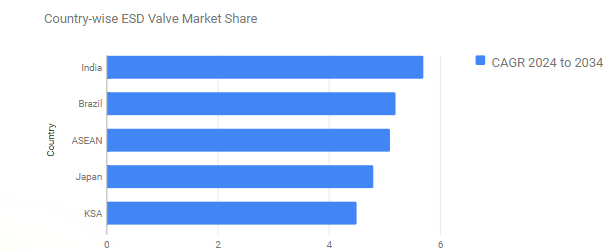Imagine a world where industrial accidents due to runaway processes or uncontrolled pressure surges are a thing of the past. Enter the ESD Valve Market, the guardian angel of process safety. These Emergency Shutdown (ESD) valves act as the final line of defense, automatically isolating equipment or entire sections of a pipeline in response to hazardous situations. By ensuring rapid and reliable isolation, ESD valves prevent catastrophic accidents and safeguard personnel, equipment, and the environment. Driven by stringent safety regulations and the ever-growing focus on industrial safety, the ESD Valve Market is experiencing steady growth. Let’s explore the diverse applications of ESD valves and delve into the key factors propelling this market forward.
Guarding Against the Unexpected: Applications of ESD Valves
ESD valves come in various configurations and sizes, catering to the specific needs of different industries and processes:
- Oil & Gas Industry: From offshore platforms to refineries, ESD valves are critical for safety. They isolate pipelines and equipment in response to emergencies like fires, gas leaks, or pressure spikes, preventing explosions and safeguarding personnel and infrastructure.
- Chemical Processing: Chemical plants handle volatile materials that can react violently if uncontrolled. ESD valves play a crucial role by isolating equipment and preventing the release of hazardous chemicals in case of malfunctions or accidents.
- Power Generation: Malfunctions in power plants can have devastating consequences. ESD valves isolate critical components like boilers and turbines during emergencies, preventing equipment damage and potential releases of harmful substances.
- Pharmaceutical Production: Strict safety protocols are paramount in pharmaceutical manufacturing. ESD valves isolate equipment and prevent contamination in case of process upsets, safeguarding product integrity and personnel safety.
- Water Treatment Facilities: Even water treatment plants can harbor safety risks. ESD valves isolate equipment and prevent the release of contaminated water in case of malfunctions or accidental breaches.
Get Exclusive Sample Copy of the Report: https://www.futuremarketinsights.com/reports/sample/rep-gb-19189
A Market Focused on Safety: Growth Factors and Opportunities
The ESD Valve Market is experiencing a surge in popularity driven by several key trends:
- Stringent Safety Regulations: Governments worldwide are implementing stricter regulations mandating the use of ESD valves in hazardous industries. This ensures rapid response and isolation capabilities in case of emergencies.
- Focus on Industrial Safety: Companies are prioritizing safety measures to protect their employees, the environment, and their assets. Investing in robust ESD systems with high-quality valves demonstrates a commitment to preventing accidents and mitigating potential losses.
- Growth in Complex Industrial Processes: Modern industrial processes are becoming increasingly complex, making the potential for malfunctions and accidents higher. ESD valves provide a critical safety layer in these sophisticated systems.
- Advancements in Technology: Manufacturers are constantly innovating, developing ESD valves with improved response times, remote monitoring capabilities, and better integration with advanced safety control systems.
- Focus on Sustainability: ESD valves play a role in sustainable industrial practices by preventing accidental releases of hazardous materials and environmental contamination.
The global ESD valve market is estimated to be valued at USD 315.9 million in 2024 and USD 581.9 million by 2034. Global ESD valve sales are anticipated to surge at a CAGR of 6.3% throughout the assessment period.

Challenges and Considerations
The ESD Valve Market also faces some hurdles:
- High Initial Investment: ESD valve systems can be expensive to install and maintain. However, the long-term benefits in terms of preventing accidents, minimizing downtime, and safeguarding lives outweigh the initial cost.
- Proper System Design and Integration: Effective ESD systems require proper design and integration with other safety components. This necessitates expertise and collaboration between engineers and safety professionals.
- Regular Maintenance and Testing: ESD valves require regular maintenance and testing to ensure they function flawlessly during emergencies. Implementing robust maintenance protocols is crucial.
Get Full Report Now: https://www.futuremarketinsights.com/checkout/19189




